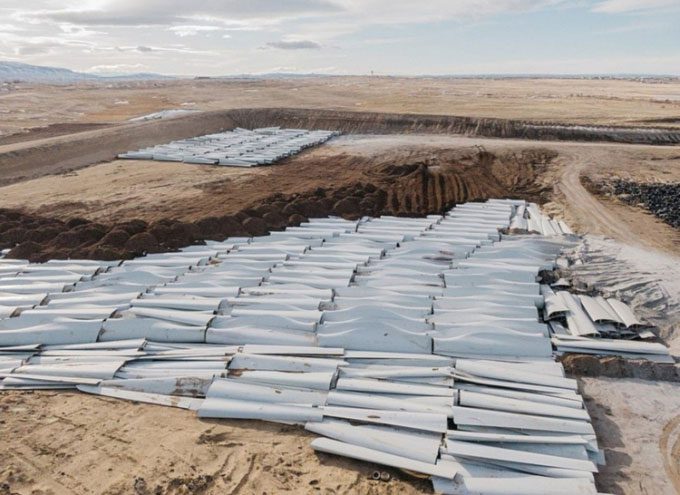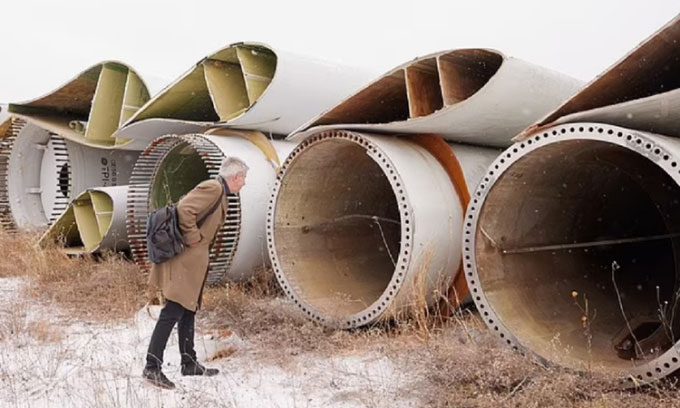Without effective recycling measures, wind turbine blades that reach the end of their 25-year operational cycle pose a new threat to the environment.
From the town cemetery in Sweetwater, Texas, across the road lies another graveyard. Here, approximately 4,000 used giant wind turbine blades are stacked, occupying nearly the entire area of a field measuring about 10.1 hectares, Mail reported on February 27.

Without effective recycling measures, old wind turbine blades are stacked in Sweetwater. (Photo: Benjamin Rasmussen)
Wind turbine blades can be longer than the wings of a Boeing 747—over 90 meters—and weigh up to 8 tons, requiring them to be cut into three pieces. They remain massive, despite being increasingly covered by weeds. They have been here for five years and will almost certainly remain for many more.
These giant white wind turbines are proliferating on land and at sea, providing renewable energy to the world. However, they come with a hidden environmental cost that is rarely discussed: they do not last forever. In fact, wind turbines typically operate for only 20 to 25 years. Additionally, the blades are made from fiberglass and plastic to withstand storm winds while being light enough to spin. They are not easy to crush, making recycling even more challenging.
Scientists are exploring ways to separate plastic from fiberglass or grind the blades into smaller pieces that can be used in other products. However, they face significant challenges in finding a viable method on a large scale.
Experts predict that by 2050, the world will discard two million tons of wind turbine blades each year. In the UK, this volume has already exceeded 100,000 tons annually. Currently, old blades are primarily buried in landfills and will take centuries to decompose.
The disposal of old turbine blades is expected to become increasingly difficult. The number of blades reaching the end of their lifespan will surge as those built during the wind energy boom (in the 1990s and 2000s) begin to degrade. Meanwhile, blades are being made longer to enhance efficiency, meaning even more waste will be generated.
Scientists at the U.S. National Renewable Energy Laboratory warn that in the coming decades, the world will face a “wave” of discarded blades amounting to hundreds of thousands, if not more. Used wind turbine blades do not leach toxins into the soil, but they take up a significant amount of space in already overloaded landfills.

Wind turbine blades can be longer than the wings of a Boeing 747—over 90 meters—and weigh up to 8 tons, requiring them to be cut into three pieces. (Photo: Mail)
The International Energy Agency (IEA) predicts that if offshore wind farms are constructed at every feasible location, they could generate more electricity than the world needs.
Nolan County, Texas, is home to the largest concentration of wind turbines in the United States. Meanwhile, the U.S. is the second-largest wind energy producer in the world after China. Of the 180,000 wind turbines operating in the U.S., one-quarter are located in Texas. The western part of the state is generally very flat and windy—ideal conditions for turbine installation.
Sweetwater, the capital of Nolan, once focused on wind energy development, even using turbine blades as welcome signs along the main road. However, it now hosts a massive graveyard for wind turbines. These blades are owned by Global Fibreglass Solutions, a recycling company in the U.S. For various reasons, recycling has yet to be implemented effectively.
In densely populated England, the casual disposal of thousands of old turbine blades like in Sweetwater is unlikely to be accepted. Instead, the majority of the 100,000 tons of discarded turbine blades each year will be buried in landfills. Europe strictly regulates what can be buried this way, so some blades are burned in incinerators or specialized pyrolysis plants to produce products like adhesives or paints. However, this process requires a lot of energy, and burning fiberglass also generates pollutants.
In November, a three-year project with a £2 million grant aimed at advancing research at the University of Strathclyde was announced. The project aims to recycle components of wind turbine blades for use in the automotive and construction industries. In Denmark and Ireland, blades are repurposed into bridges and bicycle parking. In the Netherlands, they are used as slides and ramps for children. However, this still represents only a small fraction of the enormous number of blades that the world is about to discard.





















































